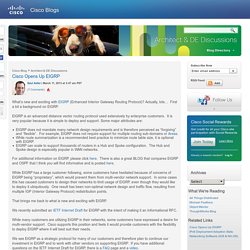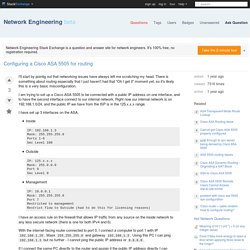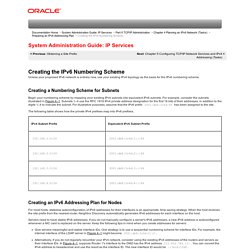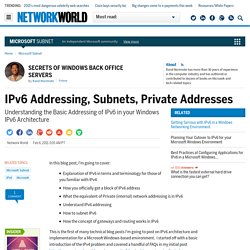

Cisco Opens Up EIGRP. What’s new and exciting with EIGRP (Enhanced Interior Gateway Routing Protocol)?

Actually, lots… First a bit a background on EIGRP. EIGRP is an advanced distance vector routing protocol used extensively by enterprise customers. It is very popular because it is simple to deploy and support. Some major attributes are: EIGRP does not mandate many network design requirements and is therefore perceived as “forgiving” and “flexible”. For additional information on EIGRP, please click here. While EIGRP has a large customer following, some customers have hesitated because of concerns of EIGRP being “proprietary”, which would prevent them from multi-vendor network support. That brings me back to what is new and exciting with EIGRP. We recently submitted an IETF Internet Draft for EIGRP with the intent of making it an Informational RFC. BRKSEC-3012_10_a6-rev2. Configuring a Cisco ASA 5505 for routing - Network Engineering Stack Exchange. I'll start by pointig out that networking issues have always left me scratching my head.

There is something about routing especially that I just haven't had that "Oh I get it" moment yet, so it's likely this is a very basic misconfiguration. I am trying to set up a Cisco ASA 5505 to be connected with a public IP address on one interface, and to have the second interface connect to our internal network. Right now our internal network is on 192.168.1.0/24, and the public IP we have from the ISP is in the 125.x.x.x range. I have set up 3 interfaces on the ASA,
[HELP] Redistribute static link in OSPF - Cisco ASA5505 - Cisco. Errdisable autorecovery. There are a number of events which can disable a link on a Catalyst switch, such as the detection of a loopback, UDLD failure, or a broadcast storm.

One of the most common causes of error disabling I've seen isn't technically an error, but a violation of a port security policy. Port security is a feature which allows for the restriction of incoming MAC addresses on a layer two switched interface. This is handy for mitigating the use of rogue devices customers purchase at Best Buy to help out with your network infrastructure design. In aggressive configurations, only a single MAC address (corresponding to the attached workstation) will be allowed inbound on a port; any other MAC address will trigger an error and the port will subsequently be disabled. A default port security policy has been applied to FastEthernet0/1 in this example: interface FastEthernet0/1 switchport access vlan 10 switchport mode access switchport port-security spanning-tree portfast Wow, really nice post stretch. Cisco IOS Device Hardening.
Security is a part of everyday life and is everyone’s responsibility.

As network engineers, it is our job to secure the plumbing that everything else rides on. While some people may consider Cisco devices (routers and switches) to already run a hardened OS, they are still vulnerable to attacks. This post will cover some of the ways you can harden Cisco devices; it is not all-inclusive. Cisco ships an IOS on every device. That IOS is never current, and if the gear has sat in a warehouse for a little while, it can be really old. Last time I checked, this was the 21st century, and we do have encrypted protocols to access the CLI. The legacy protocol to manage devices is telnet. To enable SSH, you need to configure a few pieces of information. Secondly, you must enable SSH version 2, as version 1 has some security vulnerabilities in it. Third, you need to generate RSA keys for the SSH process to use.
How to Create a Bibliography or Works Cited Page in Microsoft Word. If you need to write a research paper, chances are that you’ll also be required to include a bibliography.

Or you might be asked to include a works cited page or a list of references. These are all just different names for the same thing: a list of sources—such as books, articles, or even websites—that you used to research and write your paper. How to Create a Table of Contents in Microsoft Word. Imagine that you’re working with a really long document in Microsoft Word, like an academic paper or a big report.

Depending on the project, it might be dozens or even hundreds of pages long! Index. Unless your proposed IPv6 network is entirely new, use your existing IPv4 topology as the basis for the IPv6 numbering scheme.

Creating a Numbering Scheme for Subnets Begin your numbering scheme by mapping your existing IPv4 subnets into equivalent IPv6 subnets. For example, consider the subnets illustrated in Figure 4–1. Subnets 1–4 use the RFC 1918 IPv4 private address designation for the first 16 bits of their addresses, in addition to the digits 1–4 to indicate the subnet.
For illustrative purposes, assume that the IPv6 prefix 2001:db8:3c4d/48 has been assigned to the site. The following table shows how the private IPv4 prefixes map into IPv6 prefixes. IPv6 Addressing, Subnets, Private Addresses. In this blog post, I’m going to cover: Explanation of IPv6 in terms and terminology for those of you familiar with IPv4How you officially get a block of IPv6 addressWhat the equivalent of Private (internal) network addressing is in IPv6Understand IPv6 addressingHow to subnet IPv6How the concept of gateways and routing works in IPv6.

62141366 Cisco Any Device White Paper Enabling Employee Owned Devices BYOD in the Enterprise.